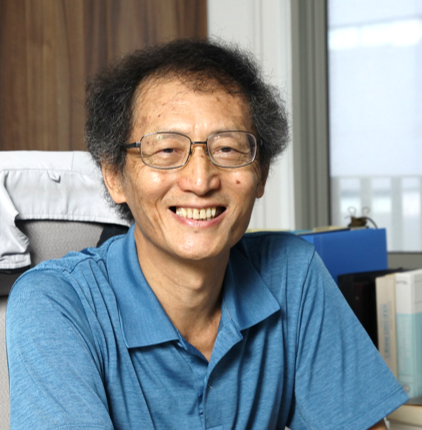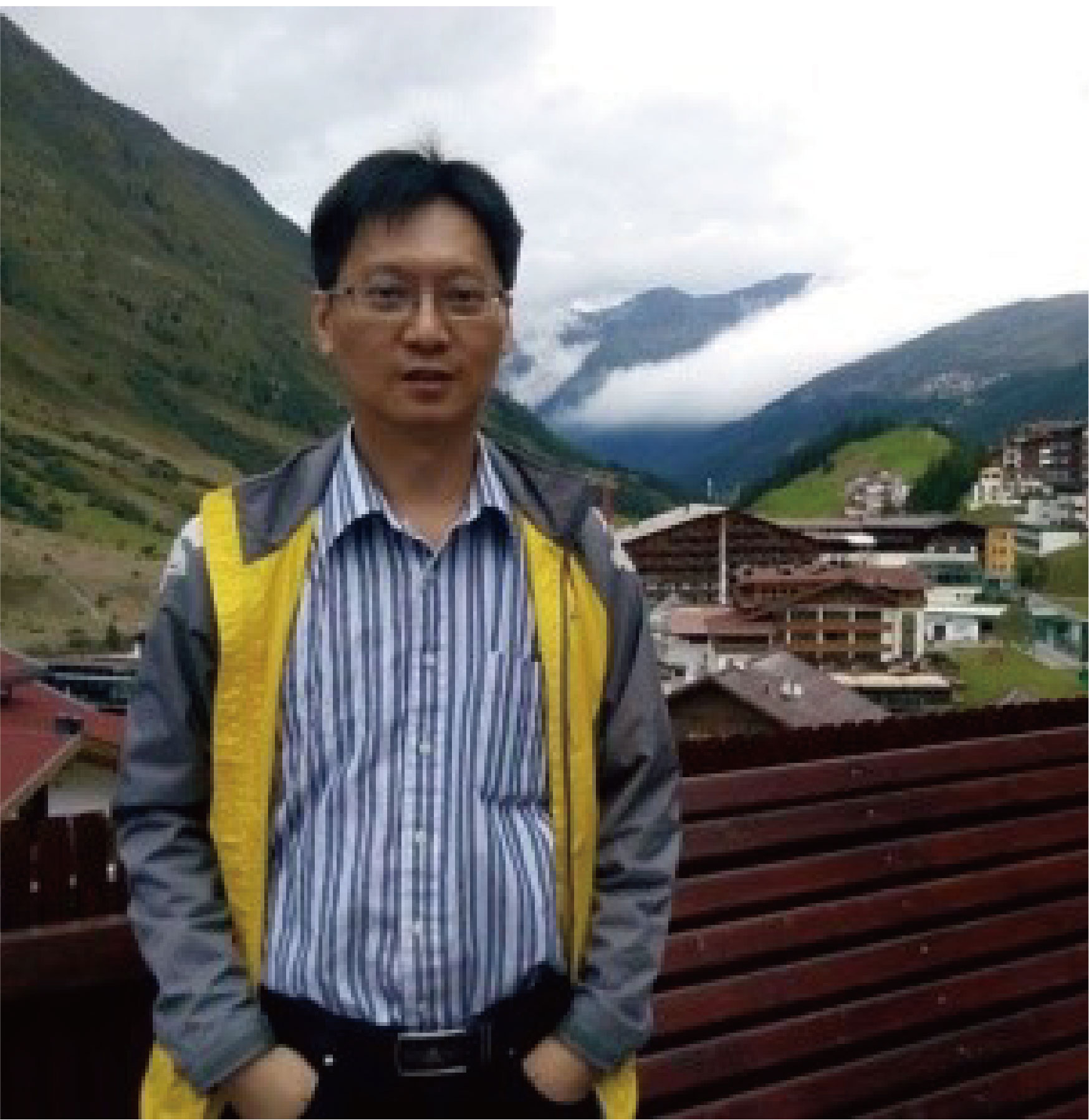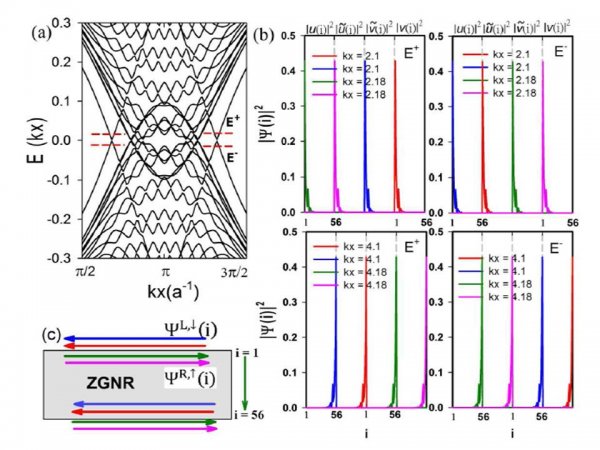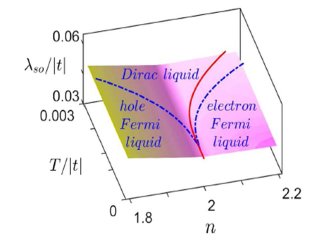


 |
Figure Caption: (a). Excitation spectrum of 2D chiral d-wave topological superconductors on a zigzag ribbon of honeycomb lattice. (b). Decay of Majorana fermions as topological edge states near the zero-energy modes of the linearly-dispersed spectrum in (a). (c). Schematic plot of the helical (counter-propagating) Majorana edge modes on a zigzag nano-ribbon (ZGNR). |
Reference:Helical Majorana fermions in dx2−y2 + idxy-wave topological superconductivity of doped correlated quantum spin Hall insulators, Shih-Jye Sun, Chung-Hou Chung*, Yung-Yeh Chang, Wei-Feng Tsai, and Fu-Chun Zhang, Scientific Reports, 6, Article number: 24102 (2016). http://www.nature.com/articles/srep24102
Prof. Chung-Yu Mou, Prof. Chung-Hou Chung (TG8) and collaborators published their research in Phys. Rev. Lett. on April 29, 2016 on theoretical realization of fermionic finite-temperature Dirac points as critical points separating two topological phases in a Kondo lattice. The underlying Dirac point is central to the profound physics manifested in a wide class of materials. However, it is often difficult to drive a system with Dirac points across the massless fermionic critical point. Here by exploiting screening of local moments under spin-orbit interactions in a Kondo lattice, they show that below the Kondo temperature, the Kondo lattice undergoes a topological transition from a strong topological insulator (STI) to a weak topological insulator (WTI) at a finite temperature TD. At TD, massless Dirac points emerge and the Kondo lattice becomes a Dirac semimetal. Their analysis indicates that the emergent relativistic symmetry dictates non-trivial thermal responses over large parameter and temperature regimes. In particular, it yields critical scaling behaviors both in magnetic and transport responses near TD. The finding in this paper is relevant for the recently heavily studied topological Kondo insulator SmB6. It also opens a new pathway to access the Dirac semimetallic phase and explore the fermionic critical point in the same system.
Prof. Mou and Chung are Coordinators of Thematic Group 8: Topology and Strong Correlations in Quantum Many-Body Systems
 |
Figure: (a)Emergence of a finite-temperature Dirac point at Xpoint. (b) Phase diagram of the Kondo lattice model. Finite-temperature Dirac points TD(red curve) play a role as fermionic critical points, separating the STI from the WTI phases.The blue dashed lines indicate the crossover temperatureT* that separates the Dirac liquid regime from the Fermi liquidregime. |
Reference:Emergence of a fermionic finite-temperature critical point in a Kondo lattice, Po-Hao Chou , Liang-Jun Zhai, Chung-Hou Chung, Chung-Yu Mou, and Ting-Kuo Lee, Phys. Rev. Lett. 116, 177002 (2016).
Gu Zhang,1,5 Chung-Hou Chung,2,3,* Chung-Ting Ke,1 Chao-Yun Lin,2 Henok Mebrahtu,1 Alex I. Smirnov,4Gleb Finkelstein*,1,† and Harold U. Baranger*1,‡
1Department of Physics, Duke University, Durham, North Carolina 27708-0305, USA \\ 2Department of Electrophysics, National Chiao-Tung University, HsinChu, Taiwan, R.O.C \\ 3Physics Division, National Center for Theoretical Sciences, HsinChu, Taiwan, R.O.C \\ 4Department of Chemistry, North Carolina State University, Raleigh, North Carolina 27695, USA \\ 5Institute for Quantum Materials and Technologies, Karlsruhe Institute of Technology, 76021 Karlsruhe, Germany
Non-equilibrium properties of correlated quantum matter are being intensively investigated because of the rich interplay between external driving and the many-body correlations [1][2]. Of particular interest is the non-equilibrium behavior near a quantum critical point (QCP), where the system is delicately balanced between different ground states. We present both an analytical calculation of the non-equilibrium steady-state current in a critical system and experimental results to which the theory is compared [3]. The system is a quantum dot coupled to resistive leads: a spinless resonant level interacting with an Ohmic dissipative environment [4]. A two-channel Kondo-like QCP occurs when the level is on resonance and symmetrically coupled to the leads, conditions achieved by fine tuning using electrostatic gates. We calculate and measure the nonlinear current as a function of bias (I-V curve) at the critical values of the gate voltages corresponding to the QCP. The quantitative agreement between the experimental data and the theory, with no fitting parameter, is excellent (Fig. 1).

Figure 1 Left: (a) Schematic of the system overlaid on a SEM image of a sample. A quantum dot is formed in the carbon nanotube (CNT) between the source and drain leads. These resistive leads create a dissipative environment for electrons tunneling through the dot. (b) Diagram of a quantum critical region as a function of a system parameter λ and temperature or voltage bias. (c) The RG flow of source and drain coupling (tS, tD) when the system is on resonance. For symmetric coupling, the flow is into the full-transmission (strong-coupling) fixed point (1,1) (path 1) which is the QCP. A slight detuning leads to a crossover to a trivial fixed point (path 2). In this work, we focus exclusively on path 1, which ends at the QCP. Right: Conductance measured in the full bias range presented as the deviation from perfect conductance 1−G(V,T) scaled by 1−G(V=0,T) and plotted vs the rescaled bias eV/kBT. Here G(V,T) is the differential conductance G=(h/e2) dI/dV and r=0.5. Gate voltages are tuned to their critical values; thus, for small V and T the system approaches its QCP (see path 1 in Fig. 1 (b), (c)). Note the excellent agreement between the theory and data in both the crossover and power-law regimes. At larger V/T, nonuniversal effects begin to set in due to 1−G(V,T) becoming non-negligible compared with 1
[1] Chung-Hou Chung, Karyn Le Hur, Gleb Finkelstein, Matthias Vojta, and Peter Woelfle, Phys. Rev. B, 87, 245310 (2013).
[2] Chung-Hou Chung*, Karyn Le Hur*, Matthias Vojta and Peter Woelfle, Phys. Rev. Lett. 102, 216803 (2009).
[3] G. Zhang, C.-H. Chung*, C. T. Ke, C.-Y. Lin, H. Mebrahtu, A. I. Smirnov, G. Finkelstein*, H. U. Barangerar*, Phys. Rev. Research 3, 013136 (2021).
[4] H. T. Mebrahtu, I. V. Borzenets, H. Zheng, Y. V. Bomze, A. I. Smirnov, S. Florens, H. U. Baranger, and G. Finkelstein, Nat. Phys. 9, 732 (2013).
Corresponding authors: CH Chung, G. Finkelstein, H. Baranger
仲教授與杜克大學的⻑期合作計畫始於2013年,探討在奈米結構中出現新穎、也是在凝態物理基礎理論十分重要的「量子相變」(quantum phase transition)現象。在古典熱力學中,物質會因溫度改變而改變其存在之狀態,例如水隨著溫度升高,從固態的冰到液態的水、再到氣態的水蒸氣之間的改變,此為「古典相變」(classical phase transition),而量子相變是在絕對溫度零度(-273度C)時,物質在奈米或以下的微觀尺度中因量子力學的擾動而產生的基態或量子相的改變。仲教授說明,當量子系統處於量子相變中的臨界點時,同時受到兩種穩定的量子態相互拉扯,存在狀態極不穩定,因而會產生有趣的「量子臨界現象」(quantum critical behaviors),即為當系統處於量子臨界點時,低溫的熱力學性質有別於兩種穩定態中的任何一種,稱為非費米液體(non-Fermi liquid)行為,此量子臨界行為也會呈現規律而漂亮的「普適性標度律」(universal scaling),即無論用多大或多小的尺度探測系統特性,都會得到同樣的臨界現象。具普適性的量子臨界行為在固態物理系統中十分重要,如同一種新的物質狀態.不同的量子相變機制會產生不同、獨特的臨界行為,藉由探討其獨特的量子臨界行為,可以了解並分類各種不同的量子相變。
近年來,量子相變與量子臨界現象在新穎的奈米材料中已廣泛地受到理論與實驗物理學家的重視,其中奈米碳管量子點(carbon nanotube quantum dot)為研究此一課題的絕佳材料。仲教授與杜克大學研究團隊共同探討奈米碳管量子點系統中出現新穎量子臨界現象,其焦點為研究系統處於此一臨界點時,電子傳導受到電阻環境的影響,尤其是,當量子點兩側加一電壓(偏壓)而使系統處於非平衡狀態時,此一量子點系統會呈現新的量子臨界現象—新的”普適性標度律”,此一新的「非平衡量子臨界現象」有別於在平衡狀態(不加偏壓)時的量子臨界行為,為近年來因奈米科技發展而形成的新基礎物理研究課題。仲教授團隊以解析計算之方法提供此一非平衡量子臨界現象之理論,完美地解釋其實驗團隊觀察到之電導率(conductance)行為(圖1,2)。
杜克大學的實驗團隊於2012年首次將奈米碳管量子點與高可調性之電阻導線做不對稱之偶合,觀察到電導率與溫度及偏壓呈現羃次方(power-law)降低之非費米液體行為[2], 可以完美地由1960年代理論學家朝永振一郎(Tomonaga)與拉廷格(Luttinger)發展具有庫倫排斥力之一維導體之電子行為之理論” --朝永振一郎-拉廷格液體”(Tomonaga-Luttinger liquid)所描述. 杜克大學團隊此一實驗成功地證實電阻在奈米線之作用如同電子間於其中產生等效之庫倫排斥力一般. 2013年,杜克實驗團隊推廣此一實驗, 將奈米碳管量子點與電阻導線調至對稱之偶合(symmetrically coupled),此時系統因為其對稱性,處於一種特殊之”強偶合共振穿隧”量子臨界點(strong coupling resonant tunneling quantum critical point (QCP)),能克服電阻環境所導致之”朝永振一郎-拉廷格液體”趨向絕緣體之行為,其低溫電子傳輸呈現與溫度及偏壓羃次方之方式接近單電子量子電導率之金屬行為,同時電導率也具有量子臨界行為之”普適標度律”(universal scaling)[3].此一量子臨界系統於平衡態之定性描述於1990年初即由理論物理學家Charles Kane 及 Mathew Fisher提出可在量子點對稱地和兩個”朝永振一郎-拉廷格液體偶合之系統中出現, 然而,當時並無對應之實驗系統, 同時,在本研究論文發表以前並沒有完整的理論計算定量地描述此一新的非平衡量子臨界現象.仲教授與杜克大學團隊此一研究成果,同時取得在實驗上與理論上的突破:在實驗上,將量子點與電阻導線調至對稱之偶合(即量子臨界點)在技術上相當有挑戰性,實驗量測主要由柯忠廷博士(杜克大學物理系博士班畢業,目前為中研院物理所助理研究員)及Gleb Finkelstein教授完成,首次於實驗中實現Kane-Fisher所提之理論架構. 在理論方面,仲教授團隊(包括已畢業碩士生林照蘊)與杜克大學Harold Baranger教授帶領的理論團隊發展非平衡量子臨界傳輸理論,以場論解析的方式得到此一系統之非平衡量子臨界電導率對任何溫度和偏壓都成立的廣義一般式,並得到”電導率之普適標度律”(universal scaling)完美而嚴格地(定量地)解釋實驗結果.無任何可調之理論參數於其中(no tuning parameter)
仲教授與杜克大學Baranger及Finkelstein兩位教授於2013年共同發想此一研究合作,雙方互訪交流,這兩位教授都是NCTS的訪客,參與由仲教授主辦的NCTS研討會,多年來雙方深入探討理論與實驗之進展,三人同為本論文之通訊作者,仲教授並於今年9月在重要之國際學術會議(Strongly Correlated Electron Systems,SCES2020)中就此一研究成果發表演講.仲教授也特別感謝科技部國家理論科學中心長期協助並支持此一國際合作研究.促成此一基礎物理研究成果。

圖1: 奈米碳管量子點與高可調性之電阻導線系統對稱偶合示意圖

圖2: 左(a) 奈米碳管量子點與高可調性之電阻導線系統SEM示意圖 (b)量子臨界點附近之相圖 (c) 量子點與兩導線偶合強度之相圖,路徑1描述量子點與導線對稱偶合,零溫時即為”強偶合共振穿隧”量子臨界點(strong coupling resonant tunneling quantum critical point (QCP)) 右: 反射電導率與偏壓溫度比之關係圖. 理論計算結果(紅線)成功描述實驗結果(有顏色之點)
[1] G. Zhang, C.-H. Chung*, C. T. Ke, C.-Y. Lin, H. Mebrahtu, A. I. Smirnov, G. Finkelstein*, H. U. Barangerar*, “Non-equilibrium quantum critical steady state: Transport through a dissipative resonant level”, Phys. Rev. Research 3, 013136 (2021).
[2] H. T. Mebrahtu, I. V. Borzenets, D. E. Liu, H. Zheng, Y. V. Bomze, A. I. Smirnov, H. U. Baranger, and G. Finkelstein, Quantum phase transition in a resonant level coupled to interacting leads, Nature (London) 488, 61 (2012).
[3] H. T. Mebrahtu, I. V. Borzenets, H. Zheng, Y. V. Bomze, A. I. Smirnov, S. Florens, H. U. Baranger, and G. Finkelstein, “Observation of Majorana quantum critical behavior in a resonant level coupled to a dissipative envi-ronment”, Nat. Phys. 9, 732
Please Click the image for more information.
A mechanism for the strange metal phase in rare-earth intermetallic compounds
稀土族金屬間化合物中奇異金屬相的形成機制
Jiangfan Wang, Yung-Yeh Chang, and Chung-Hou Chung*
Proceedings of the National Academy of Sciences (PNAS), 119, Vol. 10 , 1-9 (2022)
DOI: https://www.pnas.org/doi/10.1073/pnas.2116980119
The elusive strange metal phase (ground state) was observed in a variety of strongly correlated quantum materials at low temperatures, notably in f-electron–based rare-earth intermetallic compounds, showing quasi-linear-in-temperature resistivity and logarithmic-in-temperature specific heat coefficient. Its emergence has remained unclear, and constitutes one of the major outstanding open problems in condensed matter physics. Here, we propose a generic mechanism for this phenomenon driven by the interplay of the gapless fermionic short-ranged antiferromagnetic spin correlation and critical bosonic charge fluctuations near a Kondo breakdown quantum phase transition. It is manifested as a fluctuating Kondo scattering–stabilized critical (gapless) fermionic spin liquid. It shows ω/T scaling in dynamical electron scattering rate, a signature of quantum criticality. Our results on quasi-linear-in temperature scattering rate and logarithmic-in-temperature divergence in specific heat coefficient as temperature vanishes were recently observed in CePd1−xNixAl (Nat. Phys. 15, 1261–1266 (2019)).
近年來,一種令人費解的”奇異金屬相(量子基態)”已經廣泛地出現在各種低溫強關聯量子材料中,特別是在有局域化電子的稀土族金屬化合物中。這些奇異金屬現象的共同特點為: 隨溫度降低其電阻率呈現與溫度接近線性的方式下降,而比熱係數則以溫度的對數方式上升。目前此種奇異金屬態的形成原因與機制至今仍是凝態物理界公認的一大尚待解決的謎團。我們在本研究中提出了奇異金屬相形成的理論機制,此機制是基於在近藤消失量子相變點附近的無能隙費米子短程反鐵磁自旋關聯和臨界電荷玻色子擾動間的交互作用。 其基態表現出一種藉由近藤交互作用而穩定的”量子臨界(無能隙)費米自旋液體相”。 經由我們計算得到的動態電子散射率顯示出 ω/T 標度行為,這是典型的量子臨界特徵。在低溫時,我們預測此系統之比熱係數以對數形式發散以及電子散射率與溫度呈準線性關係。這兩種理論結果成功地解釋最近於 CePd1-xNixAl 的實驗中被觀察到的奇異金屬相 (Nat. Phys. 15, 1261–1266 (2019))。